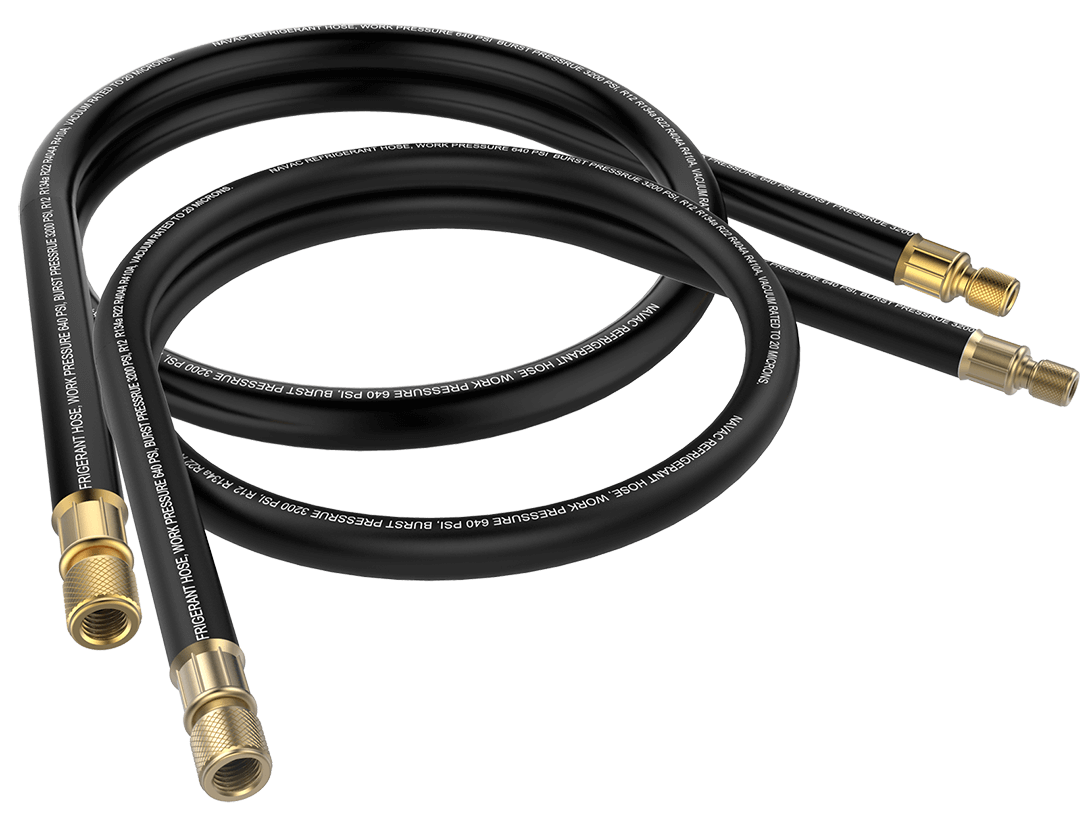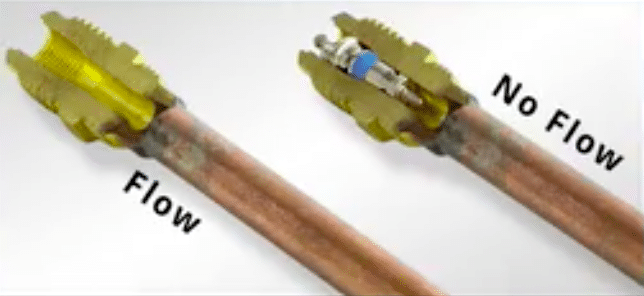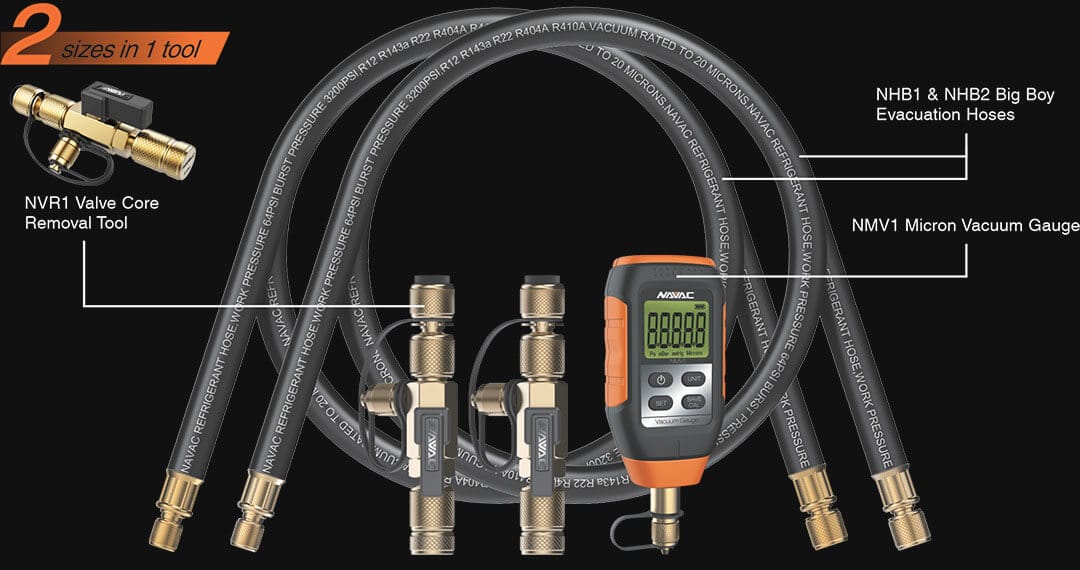In this article, we continue our 2-part series on a better approach to HVAC evacuation by reviewing the current status quo, examining its inherent weaknesses, and proposing a new, modern & efficient solution that takes advantages of improved HVAC tool technology.
Understanding the “Status Quo” of the HVAC/R Industry
For decades, these standards have been met using a 3 or 4 port manifold gauge set with ¼ inch hoses running from the high and low side of the equipment, which run through the manifold gauge and down another ¼ inch or ⅜ inch hose into the inlet of the vacuum pump. Sometimes the micron gauge is used with this set-up, often being tied in somewhere along the away, attached to another ¼ in hose. More often, however, the technician instead uses the vacuum scale on the compound gauge read-out, relying on an analog reading to go off of. In the worst of cases, all of these practices are ignored all together, and the technician goes by simple rules of thumb or rough time durations to determine complete vacuums.
Why the analog gauge reading is problematic
The outright resolution of a compound gauge is simply inappropriate in all situations regarding vacuum measurement. The gauge typically reads from 0 PSIG to 30 inches of vacuum, in the space of maybe an inch. A micron is a linear measurement, and the tip of the needle on the compound gauge is easily hundreds if not more microns, which alone is reason to not trust the readings in an evacuation setting. Add to this the typical conditions of manifold gauge sets in the field; they are often in rough shape and knocked out of calibration.
With all of these considerations, it’s easy to see why the use of a dedicated digital micron gauge is critical in proper evacuation practices.
The next big shift in proper practices: vacuum hoses
The standard ¼ inch hose sets seen on nearly all manifold gauge sets on the market are acceptable for reading and interpreting operational pressures of running HVAC equipment. However, once we venture outside of that application, particularly into pump vacuums on that same equipment, they fall short both in quality and the time it takes to do so. This is due to the fact that the tubing is too small to be useful as a connecting line to a system, making it too costly in excessive pump-down time.
Using larger diameter tubing is more efficient, as it reduces the pump-down time in field service
For instance, if we use a 10 foot line at 1000 microns, we can move roughly:
-16 CFM with ¾ inch hose
-4 CFM with a ½ inch hose
-1.5 CFM with a ⅜ inch hose
– 0.5 CFM with a ¼ inch hose
As you can see, smaller hoses only de-rate the potential of your vacuum pump. In other words, when you purchase that 8, 10, or 12 CFM pump and then tie it up to a ¼ inch manifold set, you just end up with a heavy and expensive pump that essentially functions at about 1 CFM. *This is why there are technicians that think micron gauges don’t work, or think it’s ever acceptable to run a vacuum overnight in a residential application.*
The Better Way to Achieve and Exceed Evacuation Goals
Technicians can get the elusive, deep-quality vacuum in a fraction of the time they are accustomed to by following this incredibly simple process and practice.
-
Remove the manifold from the equation all together
This is because manifolds are typically fitted with 60 inch hoses. When evacuating and maximizing speed, we want the largest diameter over the shortest distance to achieve the least resistance and fastest speeds. The manifold also has multiple hoses, which are bound to leak over time. Instead, it is best to use a one or two hose set-up, depending on one’s equipment and needs.
-
Valve Core Removal
 For most residential applications, mini-splits with just one service port, a one hose set-up is more than adequate and superior to the manifold set-up in terms of speed and depth. In this case, we affix one large diameter hose directly to our vacuum pump inlet. The hose will run from there directly to the back of a core removal tool, one that’s already been pre-installed on the service valve with the valve core removed.
For most residential applications, mini-splits with just one service port, a one hose set-up is more than adequate and superior to the manifold set-up in terms of speed and depth. In this case, we affix one large diameter hose directly to our vacuum pump inlet. The hose will run from there directly to the back of a core removal tool, one that’s already been pre-installed on the service valve with the valve core removed.
-
Add a Digital Micron Gauge

From here, in the case of a mini-split, a digital micron gauge is fitted to the side port of the same core removal tool. For typical residential systems, the gauge can be fitted to the back of a second core removal tool on the opposing service valve. The advantage here is locating the gauge as far as possible from the pump, as this gives the most accurate and real-time vacuum level in the equipment itself.
The two hose set-up is almost the same, and involves running two large-diameter hoses from the back of the pump to two core removal tools of the equipment, valve cores removed, with a micron gauge attached to the side port of one of them.
The result of this practice is maximized evacuation speed, by removing all restrictions within our power.
- We have used the shortest hoses possible with a diameter that matches or exceeds the pump’s output.
- We have removed the valve cores, which removes almost all of the restriction in the service valve.
- We have also placed the high-quality digital micron gauge in a place where it is far enough from the pump to give a good, reliable reading.
- Additionally, we leave the core removal tools on the service valves for the entire procedure, as they serve as the valves to isolate the pump from the system.
Minimal Effort for Astounding Results
Making these changes to our evacuation set-ups takes minimal effort, yet produces astounding results. Provided a clean, tight install, a residential reading should take no more than 15 to 20 minutes, and this includes the decay test! In fact, sometimes it will only take 5 to 10 minutes.
By understanding this information, and and utilizing large diameter vacuum hoses, core removal tools, and micron gauges in addition to your vacuum pumps, , you can ensure that your customers receive the best service and that you’re helping to maximize the lifespan of their equipment. And you’ll see an increase in your team’s productivity and profitability. Not only will performing faster and more effective vacuums than ever before help optimize the team’s time – it will also prolong the life of their HVACR tools.


